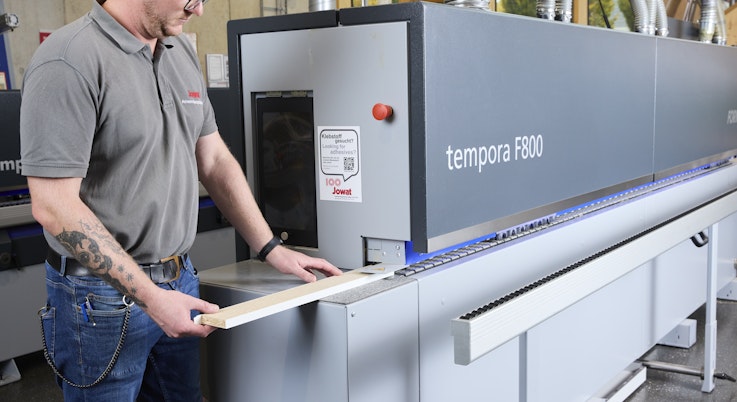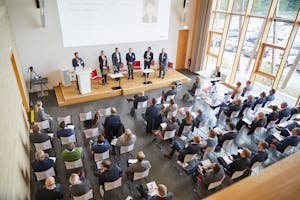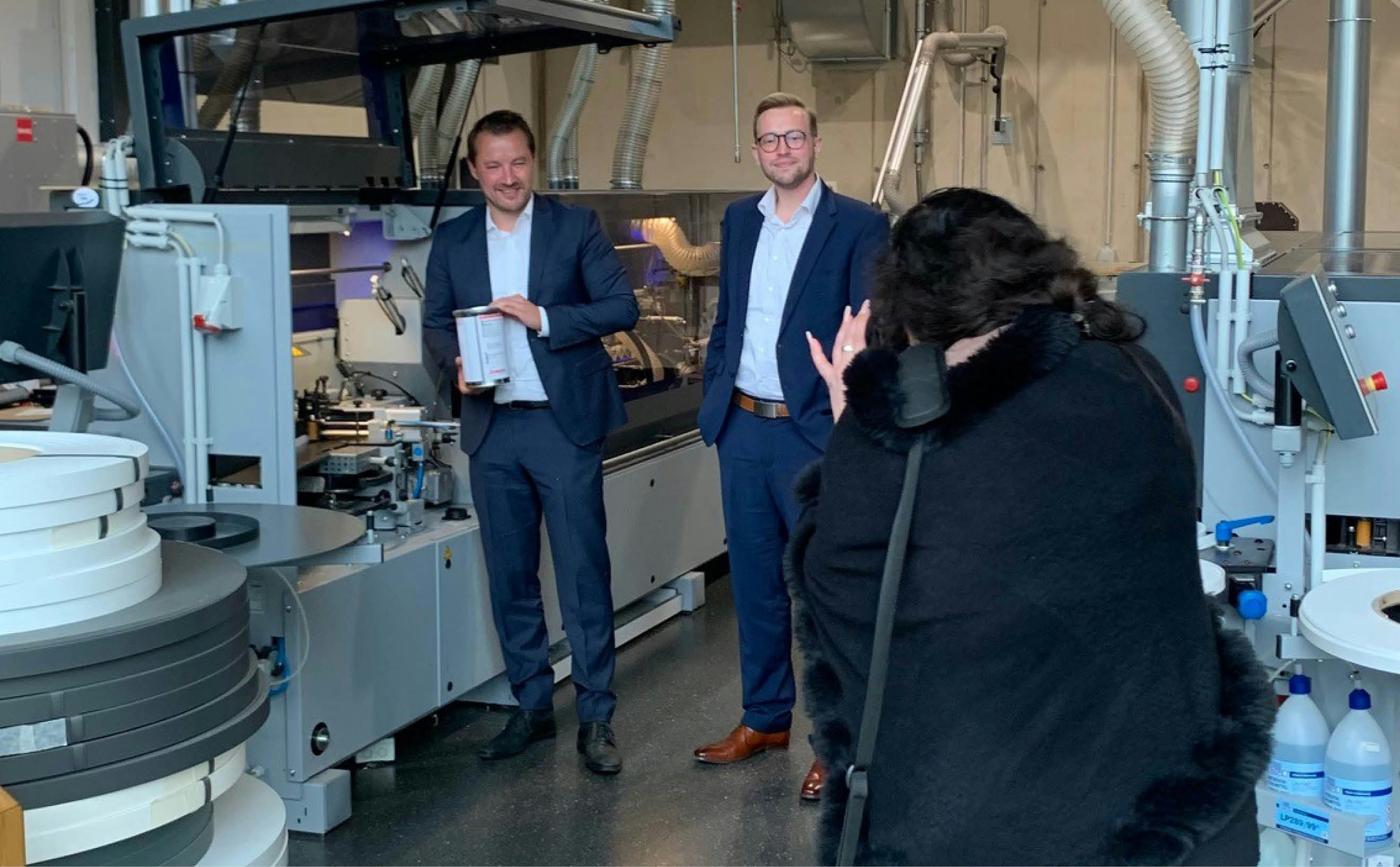A Platform for Processors, Exchange and Analytics
Mr. Horsthemke, Mr. Weymann, we are currently in the House of Technology, which opened in 2018. What are the benefits of this building when it comes to catering to Jowat’s customers in the wood and furniture industry?
Weymann: The focus is on providing a space for cooperation. Within the framework of project with our customers, we bring together stakeholders in machinery, substrate, and adhesives to find the optimum overall solution together with the processor. Due to our state-of-the-art machines, we can simulate real-world conditions and conduct straightforward preliminary trials for our customers. But it is not just the comprehensive application technology equipment that makes our services unique for the wood and furniture industry—it is primarily the people behind it. Our customers value the expertise we bring to the table. In addition to facilitating ongoing customer projects and the testing of new adhesive developments, the building serves as a hub for industry events like the Jowat Symposium, which has become a staple for networking and exchanging ideas on current industry topics.
Horsthemke: Let me throw in a few facts and figures about the House of Technology: The building covers an area of 2,500 square meters, is constructed with 850 cubic meters of wood, and boasts a 350-square-meter exhibition space. The composite wood and concrete ceiling with a span of 15 meters is a one-of-a-kind in Germany.
What are the technical capabilities of Jowat in the House of Technology, and what purposes do the machines serve?
Weymann: We have three machine shops, each focusing on different aspects. Firstly, there's a well-equipped carpentry workshop for preparing the workpieces. Then, we have a space dedicated to edgebanding. And finally, a large area housing a wide range of machines, e.g. for profile wrapping and flat lamination, along with a variety of equipment for the application of different adhesive systems. Many tests of the workpieces are carried out in the testing lab, which is equipped with several climate chambers, water basins, and ovens. Here, we can simulate a wide range of environmental conditions and thoroughly examine the bonded parts. In addition to the application-related area, the back of the building features a state-of-the-art analytical laboratory where we conduct chemical and physical analyses. For example, to identify the chemical composition of surfaces or determine bond strengths using tensile testing machines.



Sustainable adhesives are an important topic. How environmentally friendly are the solutions of Jowat?
Horsthemke: Modern adhesives are often the ones that facilitate more sustainable products, such as wind turbines or lightweight materials.
Weymann: We have to take a closer look at what sustainable actually means in terms of adhesives? For some, it is all about a high proportion of biobased raw materials. Others focus on minimizing the use of materials or reducing the energy consumption. Each company has individual goals and priorities— some are focused on minimizing the carbon footprint, while others prioritize maximizing workplace safety.
Horsthemke: Our advertising campaigns for Green Adhesives cover four four key topics: Renewable raw materials, occupational health and safety, consumer protection, and resource conservation. This Green Adhesives platform exists to provide better clarity for all stakeholders. When it comes to raw materials, we are talking about the source of the adhesive. Occupational safety focuses on the processor. Consumer protection centers on the consumer and a healthy living environment. And resource conservation aims to reduce the consumption of energy and materials in the process. Across these four categories, we offer a variety of solutions.
What role does the composition of hot melt adhesives play in this context?
Horsthemke: When we take closer look at the elements that make up a hot melt adhesive—polymers, resins, waxes, fillers, and additives—it becomes evident that the development of an adhesive involves a formulation with a mix of different substances. The challenge arises when aiming to formulate a 100 percent bio-based adhesive, where all components must align with bio-based criteria. There are, however, noteworthy constraints in this pursuit. One avenue involves tall resins, sourced from crude tall oil, a byproduct of pulp production. These raw materials do not stand in competition with the production of food or animal feed. Another sustainable option involves tree resins obtained directly. And terpene resins derived from citrus fruit peels. Again, a waste product put to good use. In addition, ethyl acetate derived from sugarcane stands out as a promising alternative for solvent-based adhesives.
Where might the trajectory of sustainable adhesives be headed?
Weymann: In the furniture industry, there is a growing interest in adhesives derived from raw materials which do not rely on newly extracted fossil resources. Therefore, there are many subsidized research projects focused on the exploration of new approaches. Jowat has played a role in contributing to many such projects. Despite promising initial results, implementation often falters due to inferior technical performance and a reluctance to embrace commercialization. The uncertainties surrounding demand quantities and the acceptance of higher product prices make it challenging to justify substantial investment costs for raw material producers. Nevertheless, our commitment remains steadfast in continuing to invest in forward-looking research projects and exploring innovative biobased or circular raw materials.
Horsthemke: Apart from the use of renewable raw materials that can be measured directly in the adhesive, there are also other possibilities to reduce the reliance on fossil raw materials. Technologies available today facilitate the extraction of monomers from biobased and recycled input materials which are polymerized into different adhesive raw materials. In terms of their properties, they do not differ from those based on fossil sources. Adhesives formulated this way do not have to be qualified anew. A straightforward and intelligent way to leverage these possibilities, gradually transitioning all chemical products from fossil to renewable resources, is the mass balance approach. It is a calculation-based method which tracks the amount of renewable raw materials and allocates them to specific products. This facilitates a flexible use of renewable raw materials—including fully circular materials—and their blending with fossil raw materials in chemical manufacturing processes. While the biogenic carbon in the end product may not be detectable, or only to a limited extent, the use of renewable raw materials remains transparent due to appropriate verification and certification systems such as ISCC PLUS, similar to the concept of green electricity.
What are your goals for the next few years in this regard?
Horsthemke: Our target is to have 80 percent of our product innovations align with our sustainability criteria by the year 2025. In addition, we will double the sales of our Green Adhesives and devise good solutions facilitating higher proportions of recycled materials within our formulations, in close cooperation with our partners.
The debate surrounding the mandatory labeling of PUR hot melt adhesives has created some uncertainty among some customers. Can you provide an update on the current situation?
Weymann: We have been supplying monomer-reduced PUR hot melt adhesives which do not require GHS pictograms since 2001. We benefit from extensive experience in the development and production of these adhesives and understand the requirements of processors. Manufacturers can improve the occupational safety in their company by changing to PUR hot melt adhesive that are not subject to hazard classification. Monomer-reduced PUR hot melt adhesives have a low content of monomeric diisocyanate (MDI) of less than 0.1 percent and are therefore not subject to hazard labeling. It is also important to observe that, as of August 24, 2023, there is a training requirement mandated by law which applies to all processors of conventional PUR hot melt adhesives within the European Union. That additional training can be avoided with products of the range of Jowatherm-Reaktant® MR range.
The production of adhesives is one of the energy-intensive sectors in the industry. How is Jowat navigating the impact of increased costs, and are you able to pass those increases on to your customers?
Horsthemke: We are actively working to significantly mitigate these increases through cost-cutting programs. Towards the end of 2021 and the beginning of 2022, there was that peak that the society as a whole experienced. The major chemical manufacturers, which are energy-intensive, are our upstream suppliers. On the one hand, we procure adhesive raw materials which have already been manufactured with high energy intensity and which carry an inherent energy surcharge. Coupled with our own production and processing, where energy intensity is once again a factor, Jowat finds itself double impacted. In Germany, we opted for transparency over cost incorporation, and implemented an energy additional that we successfully rolled back in 2022.
Jowat is soon opening a new location in the greater Shanghai area. Which markets will this facility cater to?
Horsthemke: The Chinese market is becoming increasingly important for Jowat, contributing over ten percent to our overall business. Therefore, it is the next logical step considering China’s standing as the world's largest market for furniture production. We have had sales offices in Beijing, Shanghai, and Guangzhou for several years. In our efforts to efficiently navigate high-volume, fiercely competitive segments, we are focused on optimizing our production landscape and supply chains. Through our commitment in China, we are laying the foundation for tapping into new markets that have their production hubs there, such as the rapidly growing consumer electronics market.
Have there been any investments in Jowat’s other international facilities, specifically in the United States and Malaysia?
Weymann: Absolutely, we have made substantial investments in these locations. In Malaysia, our focus was on photovoltaics, a comprehensive logistics complex and additional production lines. The same holds true for the United States, where we expanded and modernized production capacities, including a state-of-the-art warehouse. This year, we acquired the adjacent building in North Carolina to further expand our manufacturing capabilities. All in all, we are on a consistent growth trajectory.

What are Jowat’s plans for 2024? What events are on the horizon?
Horsthemke: The Jowat Symposium, which takes place every two years, will celebrate its 20 anniversary on October 10–11, 2024. Recently, we launched a new event series: the Jowat Forum. Complementing the Symposium’s cross-application focus on adhesives, the Forum delves deep into specific industry segments, offering a thorough exploration of industry topics. In the Jowat Forum, our role is more that of a bonding element. We recently organized the inaugural Jowat Forum under the headline “Adhesives & Packaging,” and were highly pleased with its debut.
And which trade shows will Jowat be part of in 2024?
Horsthemke: We will be present at the IWF in Atlanta and the Interzum Guangzhou. We will not be at the Holz-Handwerk. As an adhesive manufacturer, we have close ties to the machine manufacturing industry. Many major machine manufacturers have canceled for 2024. This was a deciding factor in our decision and we now look forward to our participation in a powerful Holz-Handwerk in 2026.
The interview is published in the magazine ''HK 06/2023" in German language. You can download the original article down below.

